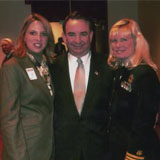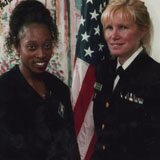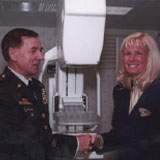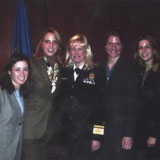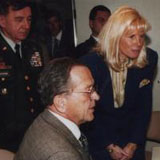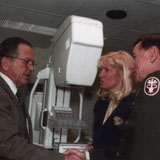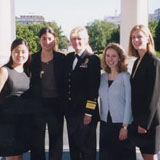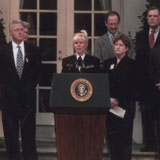Biography: Dr. Susan J. Blumenthal

Year: 1994
Achievement: Dr. Susan J. Blumenthal was the first Deputy Assistant Secretary for Women's Health, in the United States Department of Health and Human Services.
I have a very personal reason for wanting to become a doctor. When I was 10 years old, my mother developed thyroid cancer. I have never forgotten visiting her in the hospital as a child.
On the door to her hospital room was a fluorescent red and yellow sign with a white skull and cross-bones and the word "radioactive" printed in large, menacing letters. The sign was there because she had been given radioactive iodine to treat her cancer. Because of the radioactive material used for therapy, my mother was too "hot" to hug, too "hot" to receive a child's kiss. The fear and powerlessness I experienced was tremendous. The anger at the cancer was even more profound. And it was at that moment I decided to become a doctor.
Seven years later during my first year in college, my mother developed breast cancer, and eight years after that, during my last year in medical school, the cancer metastasized to her spine. She fought the disease with great courage and dignity, and lived long enough to see her daughter become a doctor. I resolved then that I would do everything I possibly could to keep other women from suffering like she did. That's why it's been a calling to spend my medical career working to improve women's health and such a great honor to have played a leadership role in the battle against breast and other cancers.
A champion for improving the health of people globally, Susan J. Blumenthal, M.D., M.P.A. served as U.S. assistant surgeon general, and senior science and E-health advisor in the U.S. Department of Health and Human Services, where her work focused on a broad range of public heath and science issues facing the nation and the world. She is an internationally recognized medical expert and leader who has been a major force in bringing important public health issues, including disease and violence prevention, women's health and mental illness to scientific and public attention, helping to place them at the top of our nation's heath care agenda. She has also stimulated many international collaborations on health issues. Most recently, Dr. Blumenthal has been involved in the national public heath response to terrorism and serves as director of the National Youth Violence Prevention Resource Center. She has also been at the forefront of applying technology to improve heath. Assistant Surgeon General Blumenthal was among the first in the government to use the internet for health education, envisioning and establishing several award winning health websites. Additionally, Dr. Blumenthal serves as a clinical professor of psychiatry at Georgetown school of Medicine and Tufts University Medical Center and as distinguished visiting professor of Women's Studies at Brandeis University. She also served as senior advisor on public health to the White House Domestic Policy Council, and to the secretary, U.S. Department of Agriculture. Previously, on a special assignment from the government, she was associate vice president for health affairs and a visiting professor of obstetrics and gynecology at George Washington University School of Medicine and Health Sciences.
From 1993 to 1997, Dr. Blumenthal was appointed and served as the country's first ever Deputy Assistant secretary for Women's Health within the United States Department of Health and Human Services in recognition of her pioneering leadership in women's health. In this position, she developed innovative national initiatives, provided oversight and coordinated research, services and education programs and activities across the agencies of the U.S. Department of Health and Human Services including the National Institutes of Health (NIH), Centers for Disease Control (CDC), and the Food and Drug Administration (FDA), ensuring that our national health programs targeted the unique needs of women. Dr. Blumenthal served as an advisor to the White House on women's health and worked with other governmental organizations, consumer and health care professional groups, to advance women's health in the United States and internationally. Her accomplishments include developing a coordinated national approach to women's health that dramatically increased attention to these issues, establishing National Centers of Excellence on Women's Health at academic centers across the country to serve as models for women's health care nationwide, establishing a focus on women's mental health issues and violence against women, fostering international partnerships, and launching initiatives on AIDS, eating disorders, and disease prevention that brought together federal agencies, private sector organizations and the media to respond to these public health problems. RADM Blumenthal also initiated a unique collaboration with the CIA, NASA and DOD (Department of Defense) called "From Missiles to Mammograms" that has transferred imaging technology used for military and space purposes to improve the early detection of breast cancer. She was the Co-chair and was responsible for the coordination and implementation of the National Action Plan for breast cancer, a Presidential initiative.
For the 12 years prior to this appointment, she directed and served as Branch Chief of major multimillion dollar national research programs at the National Institutes of Health on behavioral medicine, disease prevention, mental illness and suicide. During this period, Dr. Blumenthal was a leader in exposing the inequities in women's health research and in fostering new studies and initiatives on gender differences in health and disease. Dr. Blumenthal has chaired numerous governmental and professional organization committees and national and international conferences and commissions. For example, she served as Chair of the NIH's Health and Behavior Coordinating Committee, Chair of the Federal Coordinating Committees on Environmental Health, Technology Transfer, Youth Violence Prevention and Breast cancer, and participated as a member of the President's Interagency Council on Women and as the United States representative to the World Health Organization's Global Commission on Women's Health.
As a leading national spokesperson on health, Dr. Blumenthal has briefed Heads of State, Health Ministers, testified before Congress, and often appeared as a medical expert on national television and radio news programs. She has authored many scientific articles, edited books, and been the health columnist for U.S. News and World report and several women's magazines. She also served as Host and Medical Director for an award winning 13 part television series on health. Assistant Surgeon General Blumenthal has received numerous awards from health care professional and consumer organizations including honorary doctorates and several of the highest medals of the United States Public Health Service for her outstanding scientific contributions and distinguished national leadership in health. Dr. Blumenthal has been named by the New York Times as one of the top twelve doctors in the women's health field, by the Ladies Home Journal as one of the ten most important women doctors in the county and by the Medical Herald as one of the most influential women in medicine.
Contact Information: U.S. Department of Health and Human Services, 200 Independence Avenue, S.W., Room 727 H, Washington, D.C. 20201. Telephone: 202-260-2255, Email: Sblumenthal@osophs.dhhs.gov
What was my biggest obstacle?
When I entered medical school, women comprised only 10 percent of the first year class. At that time, female students faced obstacles in being accepted and treated equitably. Working hard and partnering with other women to break down the barriers were important elements of a prescription for change. That's why I joined with a woman scientist colleague at the National Institutes of Health to co-found the Society for the Advancement of Women's Health Research, and why as the country's first Deputy Assistant Secretary for Women's Health in the U.S. Department of Health and Human Services, I worked to advance women's health care, to foster the study of sex differences in health and disease, and to establish a national mentoring initiative to systematically address and remove the obstacles that have existed for women's career development in academic medicine.
During my career in the Federal government, I have worked to bring understudied public health issues including women's health, mental health, violence, disease and suicide prevention to increased public and scientific attention. The biggest obstacle I've encountered in trying to implement significant change has been resistance to altering the status quo. When you are involved in exposing inequalities in the health care system and gaps in science or trying to fix them, you will inevitably encounter organizational and interpersonal barriers. For example, in 1984, there was little institutional support at the National Institute of Mental Health for establishing an initiative that I developed on women's health and sex differences in mental illness. However, with persistence and by establishing partnerships across the government and private sector, we were able to expose the inequities in women's health research, services, and education and rectify them. Another example - in 1993, there was some resistance to my idea of establishing a National Women's Health Information Center that would provide a single user friendly point of access to all Federal and private sector information on women's health through the Internet and by toll-free telephone access. At that time, the agencies of the U.S. Department of Health and Human Services were not widely using the web for health education initiatives. Clearly, the Internet was going to revolutionize the way people received their health information in the future. That's why despite the lack of immediate participation by some of the health agencies, I pursued the project by partnering with the Department of Defense and piggy-backed the women's health website onto this agency's Internet infrastructure. Two years later, we began building the National Women's Health Resource Center in the U.S. Department of Health and Human Services and today this award winning resource brings cutting edge health information to millions of people worldwide.
Overcoming obstacles requires determination, creativity, and the ability to withstand criticism, but the rewards are enormous. There is nothing more gratifying than accomplishing what you set out to do¿and for me this has been contributing to the revolution that has occurred in advancing women's health, as well as shining a spotlight on other neglected public health issues including mental illness, violence, suicide, and disease prevention.
How do I make a difference?
I've tried to make a difference by identifying understudied and emerging public health issues and addressing them with innovative solutions and initiatives. A major strategy that I've used is to bring together the expertise and resources of different disciplines and organizations to catalyze new directions in a field, forming partnerships and leveraging resources across the Federal and private sectors that no one agency or person could accomplish alone. During my career, I have provided national leadership in advancing women's health, mental health, behavioral medicine, violence, suicide and disease prevention. My work has contributed to increasing public, scientific, and policymaker attention to these issues in the Federal Government and nationally at a time when there was minimal focus on these health concerns. Another way I've tried to make a difference is through mentoring a large number of students to foster their interest in careers in medicine and public health.
One of the accomplishments I am most proud of is helping to revolutionize and advance global attention to women's health issues. As a research scientist at the NIH, as the country's first ever Deputy Assistant Secretary for Women's Health in the U.S. Department of Health and Human Services (HHS), as a White House advisor on women's health, and subsequently in my other positions within the Federal government, I played a pioneering role in exposing the inequities in women's health and then have spent much of my professional career working to move women's health issues and the study of sex-based differences in disease to the forefront of our nation's health care agenda. Some of the improvements I've ushered in over the past decade include developing an infrastructure in the federal government for women's health; envisioning and establishing the National Centers of Excellence on Women's Health program at academic centers across the country to serve as models for women's health care, research, and education nationwide; creating the National Women's Health Information Center (located at www.4woman.gov and 800-994-WOMAN); establishing a focus on women's mental health issues, minority women's health concerns, violence against women, AIDS, women's cancers, girls' health; and ensuring that national disease prevention education campaigns that once only targeted men now also focus on women's unique needs.
I have worked especially hard to make a difference in the battle against breast cancer. I joined with other advocates on the frontlines to raise awareness about the disease at a time when it was not talked about openly and before it was a national priority. Then, as Co-Chair of a Presidential initiative on Breast Cancer, I worked with hundreds of government and private sector advocates, scientists and policymakers to develop and implement programs that would help eradicate breast cancer as a threat to the lives of women everywhere. Also, I established and chaired the Federal Coordinating Committee on Breast Cancer, mobilizing all Federal agencies to join in the fight against this disease. To improve the early detection of breast cancer, I envisioned and spearheaded the "Missiles to Mammograms" initiative. I believed that if the CIA, NASA and DoD had the ability to detect missiles in outer space and visualize the surface of Mars, then perhaps this same technology could be used to detect tumors in women's breasts. As a result of this program, today, the same computer software that is used by spy satellites to find tanks camouflaged behind trees is helping us to find small tumors camouflaged behind dense breast tissue, yielding a lifesaving dividend.
Over my twenty years in the U.S. Public Health Service, I have also worked to make a difference on several other health concerns. Whether it has been helping to shatter the stigma associated with mental illness, trying to prevent violence, suicide and chronic disease, or responding to terrorism, I have used the power of communication tools to disseminate lifesaving health information to the public and health care providers. I was among the first in the Federal government to apply information technology to improve health, envisioning and establishing several health Internet portals before most government agencies and other organizations had their information online. I also worked with the media at a time when most physicians were reluctant to talk on camera, served as the health columnist for US News and World Report and several women's magazines and hosted an award winning television series on women's health.
In summary, in trying to make a difference, my approach has been to integrate the perspectives of many fields into innovative strategies and public/private sector partnerships to address emerging public health issues. This includes utilizing communication tools to disseminate information to consumers, health care providers and policymakers. My most important contribution has been galvanizing a new national and global focus on women's health issues by playing a critical role in exposing the inequities in women's health, and as the country's first ever Deputy Assistant Secretary of Women's Health, helping to revolutionize and advance women's health research, education and services in ways that had not been accomplished before.
Who was my mentor?
A hallmark of my work has been the integration of science, communication, and public health perspectives. Looking back, there were three people who served as special mentors—one from each of these different fields.
During high school, I spent a summer internship working in a neurochemistry laboratory at the Stanford University School of Medicine. A Visiting Professor of Neurology from Switzerland, Norbert Herschowitz, M.D., became my science mentor and interested me in an exciting and fascinating new frontier—brain research. After medical school, I specialized in psychiatry due in part to Dr. Herschowitz' early influence.
Another summer, I worked as an intern in the News Bureau of Stanford University Medical Center. Spyros Andreopoulos, then the director of the Office of News and Public Affairs at the Medical School, taught me about the importance of translating and disseminating scientific advances to the general public, working with the media and applying the tools of health communication to improve public health. My time at the News Bureau was thrilling—for example, covering Stanford's first heart transplant surgery on the radio and helping to write press releases. The communications skills and lessons learned from this experience are tools that I have applied throughout my career in developing public education campaigns on a broad range of public health issues, serving as a medical expert in the media, hosting a television series on women's health and writing health columns for news magazines.
As the country's first Deputy Assistant Secretary for Women's Health from 1993 to 1997, I had the privilege and honor of working with Phillip Lee, M.D. who was Assistant Secretary of Health in the U.S. Department of Health and Human Services at that time. Dr. Lee, a brilliant and inspirational leader, has been my public health mentor for over a decade. While working with Dr. Lee, I established the National Centers of Excellence Program at academic centers across the country that included a women's leadership component. I also started a national mentoring initiative so that the next generation of women in academic medicine would have more mentors (including female role models that were scarce for many of us) to provide them with guidance about their career development.
My three mentors not only inspired me in their respective fields but I've integrated and woven the perspectives that they introduced me to—science, communications and public health—into the fabric of my work including teaching the next generation of physicians.
How has my career evolved over time?
Following graduation from medical school, I entered a psychiatry residency at Stanford University School of Medicine. This field, one of the most fascinating areas of medicine, enabled me to integrate my interests in science, the humanities and social sciences, in studying the human brain and in treating patients with mental illness. Following this training, in 1980, I went to the National Institute of Mental Health (NIMH) for a fellowship. My experiences at NIMH brought into focus that medical school training had concentrated on the treatment of individual patients but neglected education on population-based intervention strategies to improve health. That's why I decided to obtain another degree—a Masters in Public Administration from Harvard University—to obtain skills in epidemiology, organizational behavior, health communications and economics—tools that would help me address public health issues at the community, national and international levels. After this period of study, I was recruited back to NIMH and joined the Commissioned Corps of the U.S. Public Health Service, a uniformed service that is on duty 24 hours a day to fight global enemies like cancer, AIDS, mental illness and terrorism. From 1982-85, I served as Head of the Suicide Research Unit at the National Institute of Mental Health, and from 1985-1997 as Chief of the Behavioral Medicine Research Branch and Chair of the Health and Behavior Coordinating Committee at the National Institutes of Health (NIH). In these positions, I directed major research programs, stimulated new scientific directions in these fields, chaired national conferences and commissions, and developed public education campaigns on health issues including suicide, depression, eating disorders and sleep disorders. During this phase of my career, the emphasis was on developing the science base that forms the foundation of public health interventions, policies and educational campaigns.
During this time period, my work also focused attention on sex differences in health and disease and on the inequities in medical care that existed for women. Because women's health was not a high priority at the NIH in the 1980's, I co-founded the Society for the Advancement of Women's Health Research to advocate for more scientific attention and funding for health issues that affect 51 percent of the population.
In 1993, in recognition of this work, I was appointed as the country's first Deputy Assistant Secretary for Women's Health to direct the Office of Women's Health in the U.S. Department of Health and Human Services (HHS). During my tenure in this position, funding for women's health in HHS was increased by approximately $1 billion (30 percent) and women's health issues became a top national priority. During this phase of my career, I used the tools of public health to help move women's health and disease prevention issues to the forefront of our Nation's health care agenda.
From 1998 to the present, as U.S. Assistant Surgeon General, I've served in several capacities including Senior Public Health Advisor to the White House and to the Secretary for the U.S. Department of Agriculture. In these and in my other federal government positions, my work has focused on improving mental health, preventing violence in America and increasing national attention to the power of prevention, including establishing national health educational campaigns. Currently, my work focuses on global health issues, our national response to terrorism, and disease prevention and health promotion.
In two decades of medical service, my career has evolved from working at the individual patient level, to conducting and directing research, to designing and implementing national and global public health programs and initiatives in the U.S. Department of Health and Human Services. Today, each level of focus is an integral part of my work, as is sharing knowledge and experiences with students as a Clinical Professor of Psychiatry at Georgetown and Tufts Schools of Medicine and as a Distinguished Visiting Professor of Women's Studies at Brandeis University. And while I've been engaged in various types of activities since becoming a physician, many principles that guide my work today were learned in medical school: science, service, innovation, dedication, compassion, and an unrelenting commitment to relieve suffering and promote health through healing and hope.






